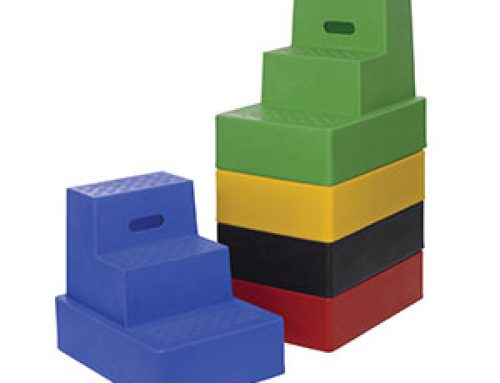Out on the open water there are many applications for ladders and similar climbing equipment. Back in the olden days you would expect to find a sailor climbing up the rigging to tend to the mast, but in modern times this has been replaced with a mast ladder. Mast ladders are hoisted up to the top of the mast using the same method as hoisting the sails. They're usually made with flexible rails so they can be rolled up for storage and flex just enough in high winds yet stay stable and intact, so even in stormy conditions a sailor can climb up to the top and see out across the horizon to check for Captain Blackbeard, or better yet, land! They can also be used to slow a sailing boat down, as trailed behind the boat they create drag in the water, which can be adjusted depending on how much of the ladder is let out.
Ladders are also used for boarding boats. These range from rope ladders to more fixed, sturdy ladders for regular use. The military has a ladder that can be attached to a RIB (Rigid Inflatable Boat) for boarding suspect boats that have taken their outer ladders in to prevent boarding. This ladder has hooks at the top (much like a chicken ladder used for roofing) that can be placed over the side of the boat they intend to board. Even though this ladder is made of metal, it still floats so it can be retrieved if it falls into the water, and used as a flotation device in an emergency.
Leisure boats often have a short boarding ladder that is used for getting back onto the boat if someone has been swimming (intentionally or unintentionally!) or diving. These ladders are fixed permanently to the side of the boat, as they provide the only easy access to a vessel that is used primarily for sport fishing, swimming or diving where you're likely to be coming in and out of the water. The length of these ladders varies depending on the average height of the side of the boat from the waterline in normal conditions, and can be either a single step, or three or four.
Large luxury yachts can be equipped with a ladder that looks more like a staircase and sits at a 45 degree angle, allowing access to and from the water without having to climb a ladder. However, due to the size and cost of these ships, there is more space to play with and the elite can afford to splash out on a more elegant boarding solution than a ladder. Folding gangways are also used to allow access from the boat to a dock, and these can be used in all sizes of vessel where it is needed, even on narrowboats and barges.
Boarding ladders for other types of boat are normally made from wood and rope, as this means the ladder can be pulled up easily, rolled up and stowed away until it is needed. Some boarding ladders are made from metal and are hinged to allow the ladder to fold away when it is not being used. Having a ladder that can be pulled in when not in use prevents uninvited people from getting into the boat. On large cargo ships this ladder is called a 'pilot ladder' as it's most often used for getting boat pilots on and off the vessel. These ladders are very long, as the deck of big shipping vessels is very high above the waterline. Because of the length of the ladder, and the often stormy conditions in which it is used, every eighth rung is much longer than the standard rungs. This stops the ladder from twisting in rough conditions by keeping it much closer and flatter to the hull of the boat. Instead of just one rope for each rail pilot ladders (and other rope boarding ladders) used a double rope on each side. This helps make the ladder stronger and more durable.
Boarding ladders are often used in rescue situations where there is a man overboard (called MOB in the maritime world). Either a fixed boarding ladder helps get the casualty back onto the boat, or a stowed boarding ladder is rolled out to assist. There are also rescue ladders designed specifically to deal with a man overboard situation. These are fixed to the side of the boat, usually along the side, and consist of either a high-tensile fabric ladder which can be pulled out of its casing by the man overboard for self rescue, or of a net which serves the same purpose but is easier to climb in rough conditions. Due to the multitude of hand and foot holds it is very easy to climb up a net in the dark and cold, much easier than to climb up a ladder.
Boarding ladders are also available for dogs. They are usually made of plastic and look more like a small set of stairs, more information about these can be found in a previous post.
On shipping barges there are high walls (called coaming walls) that can be tricky to navigate with a conventional ladder. A company inAmericahas developed a system made up of a platform that sits over the coaming walls, braced against the side of the ship and from which an extending ladder can be hung and dropped down into the barge. This makes the ladder inside the barge much more stable, and a short set of extension steps on the outside of the barge means even tall coaming walls can be overcome easily. The platform provides a space for resting goods when bringing them in and out of the barge, and also means the person going in and out has a large enough space to stand and turn round to climb down the ladder without having to balance on the top of the coaming wall.
It's not just on the exterior of boats that ladders are used though. Since sailing began ladders have been used in place of conventional stairs between levels on commercial and military ships in order to save space. The ladders are set at a slight angle rather than straight up and down, but they are ascended and descended in the same manner as a normal ladder (i.e. facing the rungs). In submarines it is more common to find ladders set vertically as there is even less space in a submarine than in a ship. The ladders in a submarine are set inside tubes as this is part of the construction of the submarine; there are watertight hatches at the top or bottom of the ladders which allows decks to be blocked off if there happened to be a leak and part of the submarine became flooded. When going down the ladders in a submarine, it is common practice to shout 'down ladder' into the enclosed tube. This lets people on the lower deck know there is someone about to descend (so they can move anything which might be in the way) and ensures that there isn't anyone climbing up the ladder, or about to climb up the ladder, thus giving right of way on the ladder. Submariners often slide down ladders in the same manner as a fireman might, especially in a highly pressured situation where every second counts, so ensuring there isn't anyone at the bottom, or that someone isn't about to throw something down the chute is a necessity.
Without ladders, most tasks at sea would be impossible, even the easiest ones such as getting on and off the ship. At least most people don't have to deal with the pitch and roll of the ocean when climbing up and down ladders, so it's no surprise that having good sea legs and a strong stomach are essential for a sailor, otherwise dealing with ladders every day would be somewhat of a challenge! Next time you're up a ladder imagine if it was on a ship, in the middle of a rough sea and be glad that the ground beneath you is solid and stationary!






Leave A Comment
You must be logged in to post a comment.